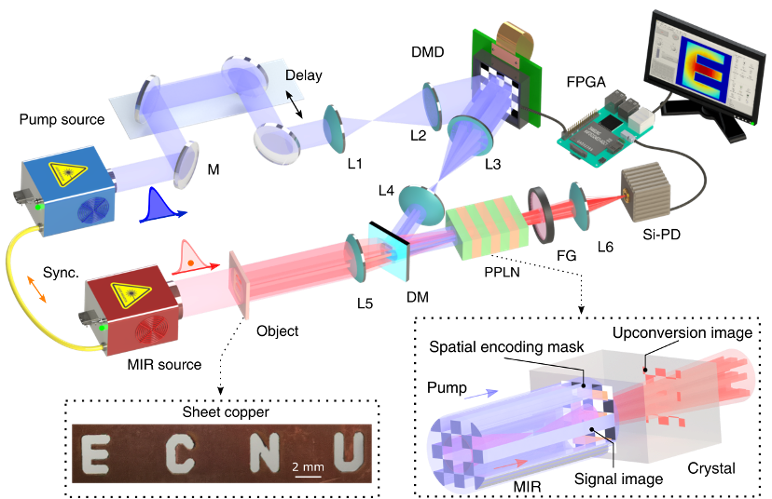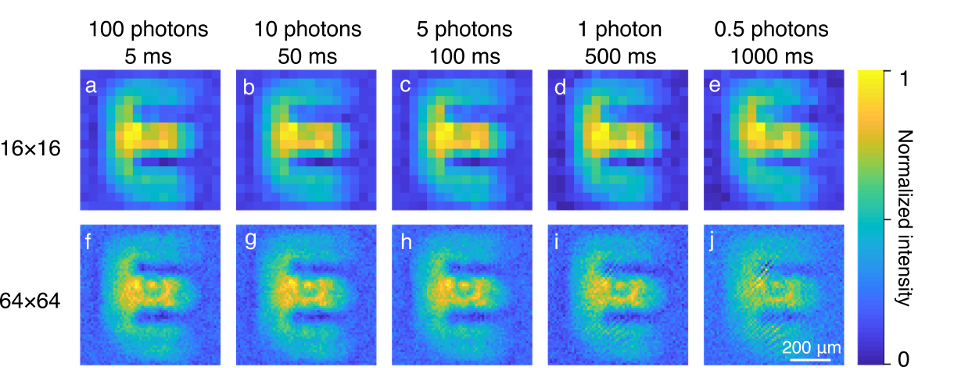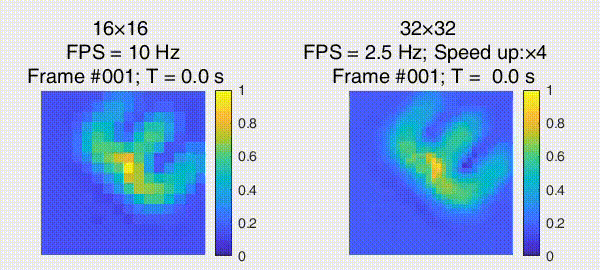Professor Zeng Heping and researcher Huang Kun of the State Key Laboratory of Precision Spectroscopy Science and Technology of East China Normal University have made important progress in ultra-sensitive mid-infrared computational imaging, proposed a new method of infrared up-conversion single-pixel imaging based on nonlinear spatial coding, and realised ultra-sensitive mid-infrared single-photon imaging by using a single pixel detector on Silicon, providing a new way for the development of room-temperature infrared photon measurement and control technology and devices. This provides a new way to develop infrared photon measurement and control technology and devices that can work at room temperature, and is expected to be applied in many fields, such as molecular mapping, astronomical observation, biomedical diagnosis, material detection and remote sensing of the environment. The results were published online in Nature Communications on 25 February 2023 under the title of " Mid-infrared single-pixel imaging at the single-photon level " (Figure 1). The first author of the paper is Yinqi Wang, a PhD student, and Prof Heping Zeng and Kun Huang are the co-corresponding authors.

Figure 1: Progress in mid-infrared single-photon computational imaging by the research team of East China Normal University published in the Nature sub-publication
The mid-infrared band contains the vibrational energy level jump spectral lines of many important molecules and is located in the spectral region of molecular characteristic fingerprints. It also covers multiple transparent windows of the Earth's atmosphere and has a better ability to penetrate haze than near-infrared light. All along, ultrasensitive mid-infrared detection and imaging are international research hotspots and academic frontiers, for the promotion of very low illumination under infrared photon measurement and control of a wide range of applications has a positive significance, such as light-sensitive materials trace detection, scattering media penetration imaging, no phototoxicity of the long-time sample observation. Currently, with the refinement of the device process and the emergence of new materials, the infrared detection performance has been greatly developed, but still faces the urgent need to solve the difficult problems such as improving the sensitivity, reducing the noise, improving the frame rate and increasing the number of pixels. In particular, the existing mid-red focal plane arrays, even under cryogenic cooling conditions, the sensitivity is only sub-nanowatt order of magnitude, the corresponding equivalent noise power of 1010 photons / sec, far from being able to achieve single-photon level of ultra-sensitive detection. Therefore, the realisation of ultrasensitive mid-infrared imaging at room temperature close to the single-photon level is still quite challenging.

Figure 2: Schematic diagram of a single-pixel mid-infrared imaging device based on nonlinear structure detection.
In recent years, single-pixel imaging, as a new computational imaging technology in the ascendant, can obtain the image information of an object by using a single-point detector without spatial resolution, which provides an attractive imaging solution for the non-visible wavelength band that lacks of mature multi-pixel array detectors, and has demonstrated an important application prospect in the special wavelength bands of X-rays, infrared, terahertz, and millimetre wave, etc. However, single-pixel imaging at the single-photon level is still a challenge. However, single-pixel imaging at the single-photon level has long been limited to the visible/near-infrared bands, with the main constraint being the continued lack of high-performance single-photon detection in other bands. In addition, the lack of high-resolution dynamic spatial modulation devices is another key challenge, especially for the long-wavelength optical field, the significant diffraction effect will inevitably reduce the spatial modulation precision and accuracy. To this end, the East China Normal University team has developed a new single-pixel mid-infrared imaging technique based on nonlinear structure detection (Figure 2), which utilises time-space precision control of pumping light field modulation to simultaneously achieve spatial encoding and frequency conversion of the infrared signal light field in a nonlinear optical crystal, and obtains highly sensitive and high-resolution mid-infrared imaging with the help of a single-point detector on a silicon substrate (Figure 3).

Figure 3: Numerical simulation and experimental results of mid-infrared single-pixel imaging based on spatial coding in Hadamard.
It is worth mentioning that the nonlinear structure detection technology developed in this work gives full play to the respective advantages of upconversion detection and single-pixel imaging, which not only breaks through the wavelength limitation of the traditional spatial modulation device and solves the problem of high-fidelity spatial modulation in mid- and far-infrared wavelength bands, but also avoids the bottleneck of the sensitivity limitation of infrared wavelength detection in the room temperature, and realises the mid- and infrared single-photon control performance that is close to the quantum limit. The performance is close to the quantum limit. It is shown that the built mid-infrared single-pixel imaging system can still achieve high contrast imaging quality under the extremely low illumination of 0.5 photon/pulse (Fig. 4), which can provide a powerful means of characterisation and analysis for photon sparse applications such as infrared microluminescence imaging, ultra-long-range ranging, and detection of deep-seated materials.

Figure 4: Ultra-sensitive mid-infrared single-pixel imaging under very low illumination at the single-photon level.
Further, the researchers combined compressed sensing and machine learning algorithms to obtain ultra-sensitive mid-infrared imaging with high signal-to-noise ratio even under sub-Nyquist sampling with a compression ratio of 25%. Figure 5 shows the real-time mid-infrared single-pixel imaging video under Hadamard spatial coding. The subsequent optimisation of spatial coding and enhancement of reconstruction algorithms can significantly improve the imaging frame rate, and ultimately lead to a new mid-infrared single-pixel imaging device with high sensitivity, high speed, and high resolution, which will provide strong support for promoting innovative applications in molecular spectroscopy, biomedical imaging, and microchip detection.

Figure 5: Mid-infrared single-pixel real-time imaging
In recent years, Professor Heping Zeng and Kun Huang have carried out a series of innovative researches in the nonlinear measurement and control of infrared photons, and have successively developed high-performance mid-infrared up-conversion photon detection and resolution technology [Photon. Res. 9, 259 (2021)], and highly sensitive mid-infrared helical-phase imaging technology [Laser Photon. Rev. 15, 2100189 ( 2021)], and large field-of-view mid-infrared nonlinear wide-angle imaging technique [Nature Commun. 13, 1077 (2022)]. The related work was supported by grants from the Ministry of Science and Technology, Foundation Committee, Shanghai Science and Technology Commission, Chongqing Science and Technology Bureau and East China Normal University.
Attachment:
Link to paper: Mid-infrared single-pixel imaging at the single-photon level
